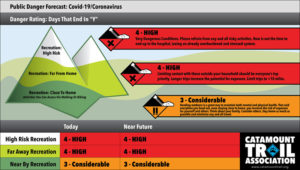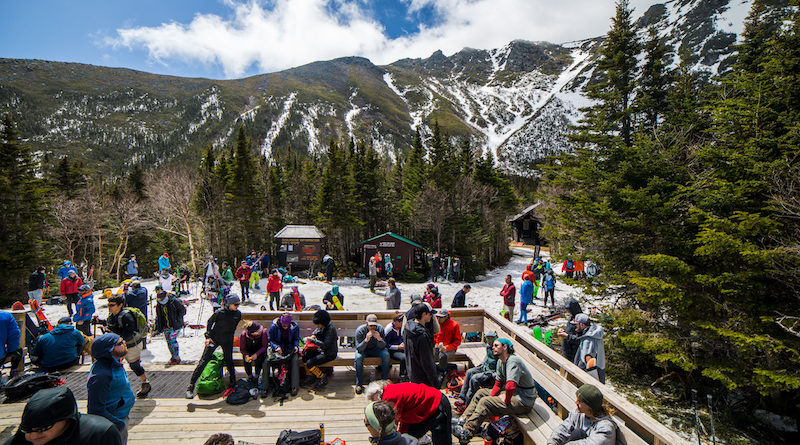Is It Time For a Real 10-Mile Limit?
For a good long time it looked as if outdoor recreation –skinning, hiking, camping—would be our savior during COVID-19.
This week, things look different. Uphill skiing has been shut down at resorts around the state and popular backcountry destinations such as Mt. Washington (shown above, during a warm day in 2018) are discouraging visitors and putting an end to the Mount Washington Avalanche Center avalanche reports.
Vermont State Parks were open (though facilities are all closed, as is usually the case in the winter months). The Vermont Venture Challenge was on, encouraging people to get outside and compete to win a free state parks pass for the year. However, the parks have hit the pause button on accepting reservations for this coming season and off-season camping has been suspended.
But was that enough?
Heather Furman, State Director of The Nature Conservancy in Vermont (the second-largest private landowner in Vermont, with 55 natural areas across the state), shared this in an email on Thursday, April 2.
With growing concerns about COVID-19 and safe outdoor recreation and the impacts on our forests and natural areas, the NGO conservation and recreation community is developing a unified message and guidance for visitors around acceptable recreation in Vermont during this temporary crisis. The Nature Conservancy is also urging the administration to take more affirmative position with regard to these guidelines, which among other things, specifically urges the Governor to announce travel restrictions for recreation limited to not more than a 10-mile radius for your home….
Though Governor Scott has recommended a 10-mile limit, the guidelines Furman referred to include stating that more clearly and emphatically:
Ask Governor Scott to take affirmative and clear steps to announce travel restrictions for recreation limited to not more than a 10-mile radius from your home. There should be clear messaging from the Governor directly and through the Agency of Natural Resources leadership. Without clear guidelines and leadership from the Administration, it becomes nearly impossible for the NGO community and municipal managers enforce what is now a set of suggestions and ‘tips’ on our lands.
This came about as Furman and others at The Nature Conservancy have seen, in Furman’s words:
- Overcrowding at many popular trailheads
- Dangerous and unmanageable parking situations
- Crowded trails, and off-trail use, especially in locations (such as on boardwalks) where it is not possible to maintain the CDC’s recommended six-foot separation. This is especially troublesome during mud-season when impacts to trails are more severe.
- Increased negative impacts on our neighbors and neighboring properties.
Trail groups were also responding. The Green Mountain Club noted: Please just do this [hiking] locally (not traveling to the Long Trail or other trail systems), with members of your own household, and stay 6’ or more away from anyone you may encounter. We recommend taking walks right out your door and exploring your neighborhood on any trails, dirt roads, or sidewalks you have available.
The Catamount Trail Association posted this graphic and said: “In practice, this means not traveling long distances to recreate, and avoiding recreation hot spots. If you show up to your local park and the lot is full you really should go somewhere else.”
.
Many of the chapters of the Vermont Mountain Biking Association were urging riders to stay off the trails — to protect the trails during mud season as well as to protect each other.
On Friday, April 3, Gov. Scott and members of the Vermont Trails Alliance, the Vermont Trails and Greenways Council and the Department of Forests Parks and Recreation released this joint statement about trail use , affirming the closure of the following trail systems.
- Green Mountain Club (www.greenmountainclub.org) – Long Trail system
- Vermont Association of Snow Travelers (www.vtvast.org) – VAST trail system
- Vermont ATV Sportsman Association (www.vtvasa.org) – VASA trail system
- Kingdom Trails Association (www.kingdomtrails.org) – Kingdom Trails network
- Catamount Trail Association (www.catamounttrail.org) – Catamount Trail system
- Vermont Huts Association (www.vermonthuts.org) – Vermont Huts
- Vermont Mountain Bike Association (www.vmba.org) – (specific VMBA trail networks will be added soon)
The underlying issues are two-fold: One, an injury on any trail would impact both a rescue crew and take away from the already-burdened medical community. Secondly, trailheads are gathering spots.
In the Adirondacks, trailheads such as the Kane Mountain trailhead, in the southern part of the park, were packed last Saturday. “Been like this for a week, daily and 95 percent from out-of-area, two to four people per car, over 75 vehicles in the course of the day, more than 4th of July week,” Caroga resident John Livingston told The Daily Gazette.
Across New York, all state-owned campgrounds, cabins and other lodging are closed through April 30. Forest rangers in the Adirondack State Park have been deployed downstate in New York to help with the pandemic in hard hit areas and around the park, organizations were imploring people to stay home.
Siobahn Carney-Nesbitt, president of the 46-rs, a club for people who climb all 46 of the ADK’s 46 major peaks posted this:
The 46ers urgently recommend that people stay home! Take travel restrictions and social distancing seriously. Go for a walk in your neighborhood or on low-risk nature hikes in your own communities in an effort to avoid unnecessary strain on DEC personnel and local healthcare facilities. Refrain from traveling to the High Peaks from outside the High Peaks region at this time. Effective 8 pm Sunday, March 22, 2020, all hikers should give the High Peaks a break.
UPDATED: Friday, April 3.


Re the ADK 46ers and other organization where certain hiking goals are sought after:
Publish that you will not “count” mountains gained toward the goal during this time.
So the “Country Club of Vermont”, to which I pay 92% higher taxes to own property as a NON-resident, is closed to me and my family to recreate/hike in rural-non-residencail areas due to Overpopulating? I’m confused. Please explain to me how I and my family hiked/walked for 3 1/2 hours -4.12 miles on a section of the Catamount Trail today and did not see another person, nor a fresh footprint. Yet you, as our Governor, are telling US , what is happening on our own , public trail system. My response to you is that you are”clueless” as to what is happening at the local level.
“This land is our land, not YOUR land.”
Be safe
Be Smart
Be AWARE!
FLATTEN THE CURVE!!